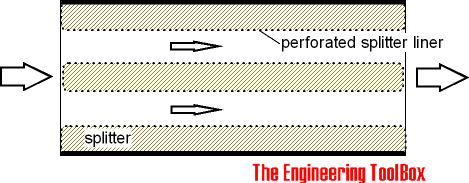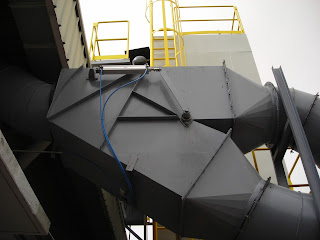Silencer
Classification of Noise Reduction Silencers
Eliminating noise with reactive silencers - diffuser type silencers - active silencers and/or dissipative silencers
The purpose of a duct silencer is to reduce the noise inside air-handling systems caused by the
- fan
- passage of air through straight ducts
- impact of air flowing through components such as elbows, branches, mixing boxes etc.
DIL - Dynamic Insertion Loss
The Dynamic Insertion Loss - DIL - is the difference between the sound power or intensity levels measured in the same point of the duct work before and after the insertion of the silencer. The insertion loss depends on the flow - if its forward or reverse. The flow is forward if air flows in the same direction as the propagation of sound.
SN - Self Noise
The Self Noise - SN - is the noise power level in decibels generated by the silencer when inserted in the air flow. The Self Noise depends on the direction of the flow - if its forward or reverse.
Absorptive or Dissipative Silencers
Absorptive or dissipative silencers use sound absorbing materials to attenuate sound waves.
Dissipative silencers are widely used in HVAC duct systems. Typical dissipative silencers are configured in a parallel baffle arrangement.

The thickness of acoustical linings or baffles should be selected with reference to the predominant frequency of the noise. The incident sound energy is partially transformed to heat by causing motion in the fibers during its passage through the material. Absorptive silencers include lined duct attenuators, packaged cylindrical and rectangular attenuators, acoustic louvers and lined plenum chambers.
Typical DIL - Dynamic Insertion Losses - with absorptive silencers are indicated in the table and diagram below
| Diameter (inches) | Length (inches) | Frequency (Hz) | ||||||
|---|---|---|---|---|---|---|---|---|
| 125 | 250 | 500 | 1000 | 2000 | 4000 | 8000 | ||
| 4 | 24 | 8 | 14 | 26 | 34 | 41 | 45 | 25 |
| 5 | 24 | 6 | 12 | 22 | 28 | 37 | 38 | 22 |
| 6 | 24 | 5 | 10 | 18 | 23 | 33 | 30 | 19 |
| 8 | 24 | 4 | 9 | 17 | 22 | 29 | 25 | 18 |
| 10 | 36 | 6 | 11 | 21 | 27 | 39 | 25 | 19 |
| 12 | 36 | 5 | 9 | 18 | 23 | 32 | 20 | 18 |
| 16 | 36 | 5 | 8 | 11 | 23 | 19 | 17 | 15 |
- (1 in) = (25.4 mm)

Reflective or Reactive silencers
The primary function of a reactive silencer is to reflect sound waves back to the source. Energy is dissipated in the extended flow path resulting from internal reflections and by absorption at the source. The operation principle of the reactive silencers is a combination of lambda/4- and Helmholtz-resonators acting as acoustic filters. Reactive silencers have tuned cavities or membranes and are designed to attenuate low frequency noise from machines.
The reactive silencer may have excellent low frequency performance, is non-fibrous and cleanable and has small or negligible pressure loss. The simplest kind of a reactive muffler is the expansion chamber. In general reactive silencers are used for fixed speed machinery producing pure tones. The reactive silencer is suitable for engines requiring very low exhaust system back pressures for a maximum engine performance.
Reactive silencers are rarely used in HVAC systems.
Diffuser or Depressive Silencers
Diffuser type silencers have perforated pepper pots to slow down flow velocity and prevent the generation of low frequency noise and are mainly used for applications involving nozzles, control valves, jet engines etc.
The total pressure drop is divided in several stages across the nozzle, the valve and the diffuser. This allows a better pressure ratio between upstream and downstream and reduces the noise level.
Active Silencers
Active noise control is sound field modification, particularly sound field cancellation, by electro-acoustical means. Active silencers use microphones and electronics to determine and attenuate noise.
In its simplest form, a control system drives a speaker to produce a sound field that is an exact mirror-image the offending sound (the "disturbance"). The speaker thus "cancels" the disturbance, and the net result is no sound at all. Such silencers can be effective at low frequencies under 300 Hz.
Active noise control is best suited for applications with relatively steady noise fields - like fans, engines or similar. Active silencers are not suitable for broadband noise reduction.


Komentar
Posting Komentar